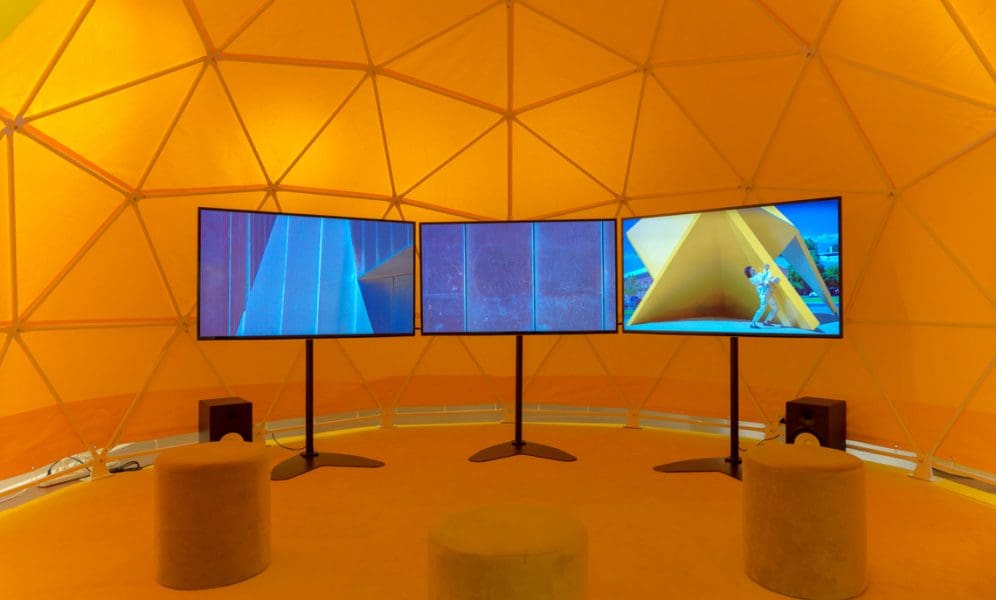
Finding New Spaces Together
‘Vádye Eshgh (The Valley of Love)’ is a collaboration between Second Generation Collective and Abdul-Rahman Abdullah weaving through themes of beauty, diversity and the rebuilding of identity.
In our new world of hibernating and social distancing, galleries are full to bursting with virtual exhibition tours, podcasts, interviews with artists and curators, videos, and more. Stay tuned, each week one of the Art Guide editors will bring you a selection of online art highlights.
The Art Gallery of New South Wales (AGNSW) is producing a series of ‘pocket exhibitions’ that give a miniature snapshot into the thematic resonances of a particular artist’s work, most recently looking at Corita Kent.
Formally known as Sister Mary Corita, Corita Kent (1918–1986) was a nun, artist and social activist. The exhibition slideshow from AGNSW charts her vivid screenprint and text-based work, especially focussing on her output in the 1960s and her push for greater civil rights during the Vietnam war.
Often blending found imagery from news sources (a pop art nun, if you will), Kent distiled her colourful text in subtly warped angles with a poignant sense of play and seriousness – a young man at war is positioned above an imposing “MAN POWER” in block text, which then sits alongside a question as innocent as the font it’s rendered in: “Where have all the flowers gone?”

Artist as podcaster: Ramesh Mario Nithiyendran
I have long-loved the hybrid ceramic creatures of Ramesh Mario Nithiyendran, and now it’s even more of a joy to listen to such an interesting artist and thinker speak with other creatives and thinkers through the new Sullivan + Strumpf podcasts.
In the latest episode Nithiyendran speaks with Diana Campbell Betancourt, artistic director of the Samdani Art Foundation, talking through aesthetic and cultural subjects in very affective, intelligent and personal ways. The pair give an insight into the creative process, the specificity of regional dialogues and the history of ceramics.
These podcasts also support Nithiyendran’s current exhibition Polymorphous Figures at Sullivan + Strumpf, which you can view online here (and it ends Friday 8 May).

This is one to note in your diary, because it launches online tomorrow (Friday 8 May) at Bega Valley Regional Gallery Online. When The Ambassador opened last year in South Australia, I witnessed an overflow of praise for Eugenia Lim, an artist of Chinese-Singaporean descent who works across video, performance and installation.
Known for bringing historical and fictive personas into her art, in The Ambassador Lim takes on a Mao-like character, complicating the given and dominant narratives that define our history and present (and the aesthetic itself is perfection, with Lim wearing a gold lamé suit).
Originally set to tour galleries in New South Wales and South Australia, The Ambassador has now lost a physical presence but can fortunately have a wider life online.

Hans Ulrich Obrist in conversation
An important curator interviewing another important curator: that’s the situation when Victoria Lynn, director at TarraWarra Museum of Art, recently interviewed the oft-dubbed ‘superstar’ curator Hans Ulrich Obrist (he is also curator at Serpentine Gallery in London).
Originally the pair were set to have a public discussion at MPavilion in early 2020 which was postponed, and now in light of COVID-19 travel restrictions has become a conversation undertaken from afar. In a mere 45 minutes Lynn and Obrist discuss experimental architecture, the powerful experience of open and accessible public art spaces (and this includes the experience of even the simplest of things, like jogging), art and life after COVID-19, upsetting our capitalist consumption, and the future possibilities of creating and exhibiting in a purely digital realm.
It’s essential listening for beginning to understand the poetic, social and political position of contemporary art in our current moment.
Mavis Ngallametta: Show me the way to go home
In 2019, and just four months after her major survey exhibition at Queensland Art Gallery (QAG) was confirmed, Mavis Ngallametta sadly passed away – however the artist declared her wishes for the show to still continue.
An elder of the Putch clan and a cultural leader of the Wik and Kugu people of Aurukun, Ngallametta’s art drew from her culture and Country, resulting in important works of great resonance and innovation. While this blog entry from QAGOMA gives great insight into Ngallametta’s practice, you can truly get a sense of the artist’s gravity and beauty through a series of videos in which Katina Davidson, curator of Indigenous art at QAGOMA, explores the overarching preoccupations of Ngallametta’s art.
In a series of short yet informative walkthroughs, Davidson discusses everything from Ngallametta’s early period to her initial work as a weaver to her visual capturing of bushfires and ghost nets.